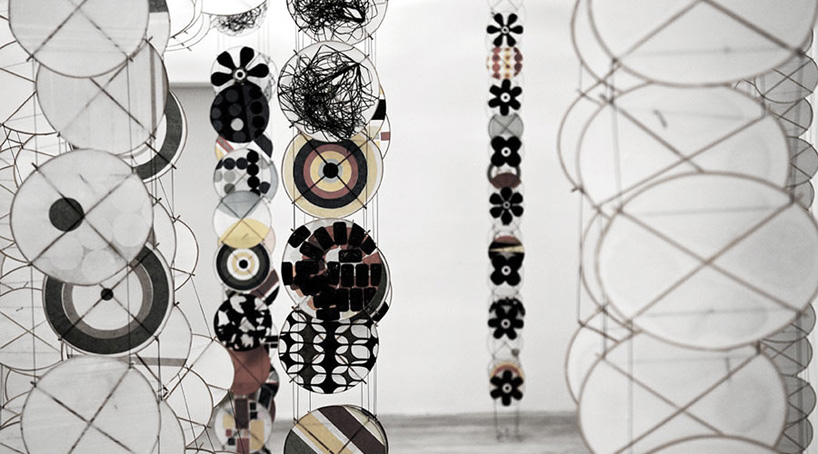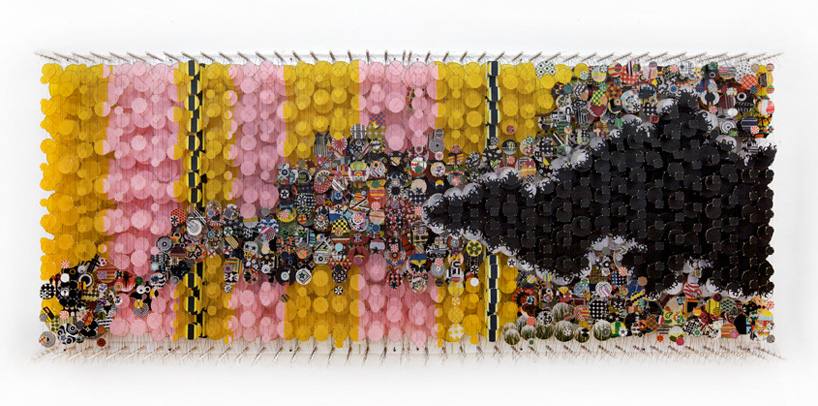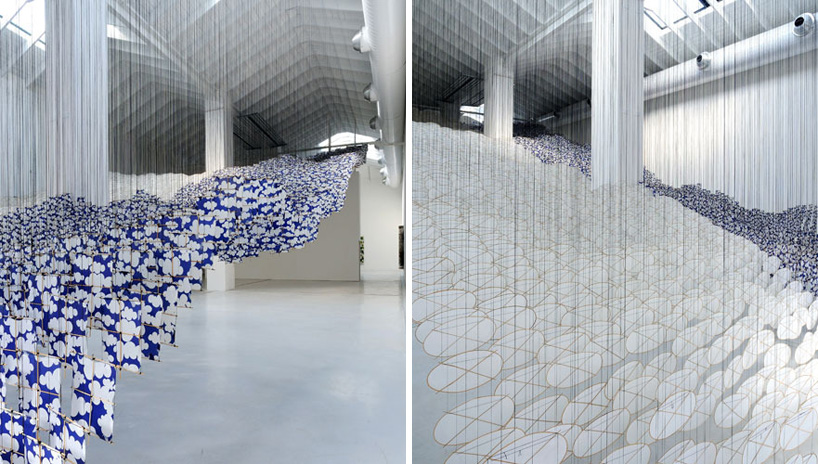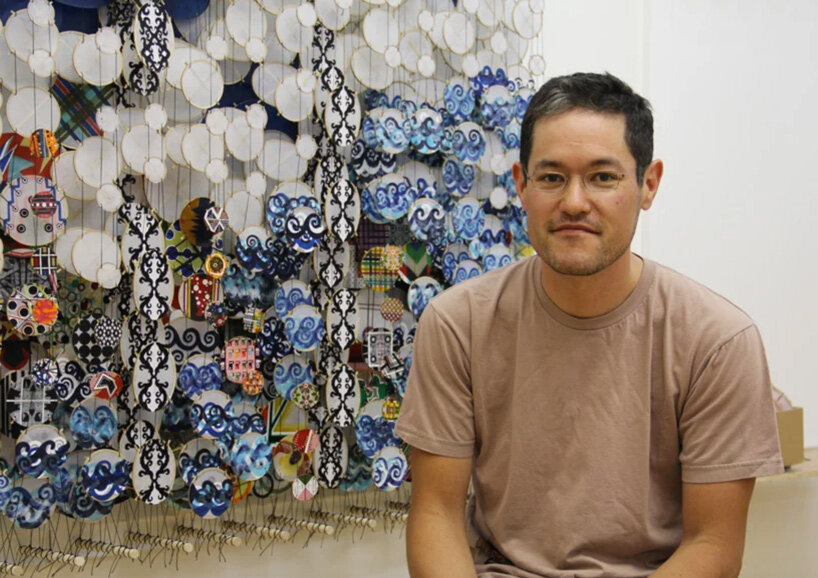jacob hashimoto was born in greeley, colorado 1973. currently living and working in brooklyn, new york the artist of japanese descent draws on his ethnic origins through is work, redefining the screen painting of japan through the assemblage of small paper ‘kites’ which he layers into larger compositions. the individual components themselves are abstract, but when arranged together, they result in graphic imagery composed of clusters of patterns, strips, waves of color creating pictorial images which suggest depictions of vistas, landscapes, scrolling video games or board games. these graphic collages are formed through strings of ‘kites’ which are stretched taut between short dowels that project from wall-mounted brackets, resulting in a densely layered and fragmented tapestry of image or pattern.
designboom met the artist in his brooklyn studio, where we spoke with him about the evolution of his work, his taste in music, references to asian cultures and artistic influences.
designboom: what is the best moment of the day?
jacob hashimoto: in terms of studio practice, the best time is probably between 9 – 10:30 at night. for me probably the best moment is before I get started in the morning. I get up and I ride my bike before I come into the studio, so there’s a lot of peace and quiet right before the day starts and my assistants get here. when I’m working hard on a show, the most productive time is in the evening though. after everybody’s gone, I take a nap at 7:00 and get up, have a coffee and then I can really settle into what I am doing. when you work with as many assistants as I work with, it’s kind of like those moments of peace and quiet are so precious, and you only get that at night here.
designboom: what kind of music do you listen to at the moment?
jacob hashimoto: I was listening to the red house painters this morning. if I’m riding my bike, I’m listening to a lot of maserati or LCD sound system. in the studio I tend to listen to books on tape and pod casts a lot more. but, typically kind of down beat stuff and sun kil moon (acoustic).
designboom: do you listen to classical music, opera?
jacob hashimoto: I do. it’s interesting because I played violin from the time I was a pre-schooler until I was in junior high school and I used to have to go to orchestra camp in the summer (laughs), and I hated it. but I’ve continued to listen to a considerable amount of classical music. symphonic music is actually much more integrated and it’s more part of the fabric of life. opera is something you have to educate yourself about. you have to make sure you understand the stories, what was happening politically, socially during the time these things were made and how they’ve changed through history. as americans, I think it’s harder for us to have a relationship with opera because the access to it is so limited.

‘silence still governs our concsiousness’, 2011 | installation at galerie forsblom
portrait of jacob hashimoto © designboom
designboom: do you listen to the radio?
jacob hashimoto: yes, WNYC quite a bit, and podcasts are the media that people bring into the studio. I have a rotating cast of assistants of all different age groups, and the studio’s open for whatever anybody wants to listen to.
designboom: what books do you have on your bedside table?
jacob hashimoto: I have a book on fly fishing in new york state, a book on chi running and I’m reading the second volume of a book on the hermaneutics of sacred architecture…and what else is on there? the ‘just kids’ that patti smith’ book.
designboom: do you read design / architecture / fashion magazines?
jacob hashimoto: I don’t actually. I really don’t. I subscribe to the new yorker and the economist and that’s pretty much it. I look at a lot of stuff online…designboom! I used to get dwell magazine and my parents got me AD (architectural digest) for a while when I was younger, but it’s just a lot of paper. I don’t really want to deal with.
designboom: where do you get news from?
jacob hashimoto: mostly from NPR and the new york times.

‘silence still governs our concsiousness’, 2011
installation at galerie forsblom
designboom: I assume you notice how women dress. do you have any preferences?
jacob hashimoto: if you go to a gala event and everybody’s dressed up. you always want to see people who are just like a little outside of the box. maybe making mistakes sometimes. not taking something that’s straight off the runway, but mixing and matching things. old and new. you can tell when women have a sensibility about, or a sense of bravery or a sense of understanding about their personal style that’s outside of what you see from a magazine. it’s like when you’re an art student you imitate rothko and ellsworth kelly or lucien freud or something, and once you understand that vocabulary you’re able to cobble these things together to kind of create your own image and I think you can see that with women that really understand fashion.
designboom: what kind of clothes do you avoid wearing?
jacob hashimoto: I was just shopping yesterday and usually I don’t go for really bright colors (I do in art work). it’s interesting because I was at agnes b. and one of my friends grabbed a pair of shorts and she was like, ‘would you wear these?’ — ‘no way.’ because they look like one of my kite patterns. they’re awesome, and I can see how they can work in my artwork, but to actually wear them I think I’m more of a neutral sort of person. I kind of don’t want to be the star of the show.
designboom: do you have any pets?
jacob hashimoto: I would love to but I just travel way too much.

‘silence still governs our concsiousness’, 2011
installation at galerie forsblom
designboom: when you were a child, did you want to become an artist?
jacob hashimoto: I grew up in an academic family and I wasn’t encouraged to take art classes. instead I was encouraged to take a lot of academic course work and the goal was to get me into the best college. I soon realized that I didn’t have a great passion for academia and I didn’t like sitting in front of the computer all day. I would much prefer to be a carpenter. my second year I started taking some art classes and some photography courses. my mother was kind of a weekend painter so there was a studio in the house and I messed around with all kinds of stuff, so it was definitely part of my life. I don’t think I thought about career as much to be honest.
designboom: where do you work on your artwork and projects?
jacob hashimoto: I used to work at home a lot, but about four years ago I put limits on that. it’s necessary when you start and especially when you’re in your early twenties and you’re getting on your feet. it’s really part of, you live, eat, breathe artwork. you do it all day, all night. most of us were working other jobs so every free moment you were trying to squeeze it in. now with normal studio hours I wanted to have a safer zone — in fact, I don’t have any of my art work in the house.
designboom: do you discuss your work with other artists?
jacob hashimoto: right now I’m talking to a lot of people. it comes and goes. it depends on if I’m in the middle of a project or if I’m kind of in a conceptual transition.

‘silence still governs our concsiousness’, 2011
installation at galerie forsblom
designboom: describe your style, like a good friend of yours would describe it.
jacob hashimoto: kind of landscape-based abstract artwork that has a heavy design influence. it tends to take design as a marker of culture and takes it from different areas that represent different periods of time, different parts of the world and kind of weaves them together to create kind of a tapestry of… it’s the life that I see around me. so they’re kind of like cultural landscapes.
designboom: describe an evolution in your work, from your first projects to the present day.
jacob hashimoto: I haven’t restarted. it’s been pretty linear. I come from painting and print and I think it’s evident in the way I kind of work with layering and things like that. at first I was working with a kind of field painting sensibility. I was very interested in postwar american abstraction and these huge visual fields I could create out of single elements (people like agnes martin, jessica stockholder). after school I moved to LA where I made these kind of light and space influenced huge billowing sculptures, but typically out of one repeating element over and over. so creating differences in the pattern by the way the sculptures were shaped. undulating waves, spaces that you build within that. density created a secondary pattern. and then when I started coming more to the east coast and working more in europe, I was working on a smaller scale and I would sit around in my little apartment in verona (italy) and would make little collages at this small table, and finally at some point I’ll just put these 25 pieces together to makes this thing (showing one of his kites) and from that all this other work grew out of it because I realized I could go back and play with a lot of painting motifs and I could crib off other painters so it’s like there’s a whole issue of um…appropriation.
designboom: appropriation or citation?
jacob hashimoto: citation, you could say that (smiling). I was talking to one of my assistants this morning and she was making something that looked like another one of my assistant’s. he said, ‘oh, she’s totally ripping me off,’ and I said, ‘she should!’ (laughing). that’s what you do. you steal stuff. the great thing about the kites is when you’re working with the collages, ‘I’m going to have a day of just doing ellsworth kelly riffs. if anyone asks me who my heroes are you just go through and ‘oh, you know there’s the bridget riley right there, or there’s a murakami piece right there,’ so you can play with kind of snippets of what they do very directly, because by the time it gets filtered through the entire process in the studio it gets on the wall… anyways it allows you to kind of to be a little bit more playful in terms of how you use references and stuff.

‘silence still governs our consciousness’, 2010
MACRO rome contemporary art museum

‘silence still governs our consciousness’, 2010
MACRO rome contemporary art museum

‘silence still governs our consciousness’, 2010
MACRO rome contemporary art museum
designboom: your kites are a sort of frame, but do they also refer to asian cultures / heritages?
jacob hashimoto: the reason why the kites came into being was that I was talking to my father on the phone one day and I was having a lot of problems in the studio because I think as a young painter, painting is such a difficult discipline. it’s so hard to make a good painting, it’s so hard to make a relevant painting, to have a voice within that dialogue… I think that a lot of young painters face this kind of block. look at art history and there’s just this astounding amount of things you can’t get away with. you’re faced with – how do you create a voice out of something that has been done to death. and I was talking to my dad about this. he’s a writing professor, he said that is similar to when he is doing journal writing exercises with the students — it’s stream of consciousness and when you reach the end of a thought and you have no other ideas –, he encourages people to write the same word over and over and over. so when your mind is ready, again your body’s already in action. his suggestion was that even if I’m not making paintings I should go to the studio and do something (you could build model airplanes or kites or something…
kites are hard to make and to make them fly it takes experience but when I was a kid my father never taught me how to build kites. it’s one of these things where it feels like with andrei rublev, the story where the bell maker’s father dies but didn’t tell him how to make the bells? (laughs) so, I went through this process of learning how to build kites and I would go across the studio to the park and fly them. there was my friend john landaway and I would drag him out there and make him run with these kites and I’d have this little pixel vision camera and shoot pictures of him, grey dot shimmering.there is such a strong tradition of kite making in so many asian cultures (I think it comes from weifang, china originally). so it’s the reference that people have but I think that truth be told you could also talk about hippy culture and the pacific northwest of these kites. it’s really a marker, for me it’s a marker of optimism and kind of childishness. there’s a child-like quality and a sense of nostalgia because it’s there’s also something about loss (and the loss of the culture of those kinds of games) and the connection to nature (we don’t have anymore). all those things are more interesting to me than maybe its relationship to asia.

‘silence still governs our consciousness’, 2010
MACRO rome contemporary art museum

‘silence still governs our consciousness’, 2010
MACRO rome contemporary art museum

‘silence still governs our consciousness’, 2010
MACRO rome contemporary art museum
designboom: what project has given you the most satisfaction?
jacob hashimoto: probably the first big piece that I did at the museum of contemporary art in chicago in the late 90s. I have the most long-term satisfaction out of that because it was something that I built on faith almost. nobody told me to do it. I did it by pure will and determination and I think that I’ve always been proud of that piece because of that.it was so big, it was so physically demanding and I did a majority of the work on my own.
designboom: who would you like to design something for?
jacob hashimoto: I’d just like more time (smiles and laughs). I think there’s a big rush these days. there’s a lot of demand for the work and I don’t want to let a lot of work go too soon, but the problem is all the work’s already spoken for you. if I had more time to keep things and to live with them and to have a more in depth relationship with them, I would like that. creatively I’m in a fortunate position because we have the capacity to do pretty much whatever I want to do. we’re working on a series of cute injection molded plastic cubes right now that we’re doing for this show with rhona hoffman (gallery). I had the idea three weeks ago and we’ve already done the models. we’re sending the vector drawings off to the printmaker, we’re talking about getting the dyes cut, all the injection molding done…it’s terrific because now, and that’s my virtue of years working in this business, we work with some really good fabricators that can make stuff happen. so I think that I the biggest thing that I need is more creative time. more time to make mistakes.

‘superliner’
paper, bamboo, acrylic, dacron
H65″ x W155″ x D8″

‘the air smelled of subversion and boundaries all glitter with bright sourceles’
paper, bamboo, acrylic, dacron
152.5 x 366 cm

‘connections and obstacles’, 2011
paper, bamboo, acrylic, dacron
H48″ x W48″ x D8″
designboom: is there any artist from the past, you appreciate a lot?
jacob hashimoto: I mentioned briefly post-war american abstraction. I think those guys are important. do you know all the light and space guys from southern california: bob irwin, james turrell… and there are people that I reference and I’m not sure if I love them or don’t love them (laughs). people like bridget riley (who I think people see in my work sometimes) it’s a marker of something and so I use it. it’s funny that if you had asked me this 15 years ago I probably would have had a very long list of artists that I loved, but it gets smaller and smaller and smaller. I mean there are a lot of people that I respect a lot.
designboom: and those still working / contemporary?
jacob hashimoto: turrell’s still alive. I think he’s interesting. it is just amazingly inspiring when you start talking to him and hearing about his projects and listening to the way his mind works. I think it’s fascinating that he’s managed to stay so engaged in the process of art. I’m more interested in the arch of artist’s studio practice as opposed to individual artworks. how you keep reinventing this love affair that you have to have with making artwork. it’s a marriage where you have this more complex relationship as you get more experienced. when I meet people, that that have been around for a long time and are still so curious and so interested in life… I think that if you can manage to maintain that childlike sensibility, that’s really magical.

installation view of:
‘infinite expanse of sky’, 2008-2009 – dimensions variable – vellum, bamboo, wire, wood
‘superabundant atmosphere’, 2008-2009 – dimensions variable – silk, bamboo, wire, wood

‘infinite expanse of sky’, 2008-2009
‘superabundant atmosphere’, 2008-2009

‘infinite expanse of sky’, 2008-2009
‘superabundant atmosphere’, 2008-2009

‘infinite expanse of sky’, 2008-2009
‘superabundant atmosphere’, 2008-2009
designboom: what advice would you give to the young?
jacob hashimoto: I’ll give the same piece of advice amy sillman gave to me. I saw her at the brooklyn museum a few weeks ago and I reminded her of when she was a professor of mine, she said to me, ‘you know it doesn’t matter how good you are. it matters how long you stick around.’ (laughing) so, I mentioned that to her and she’s like, ‘ya it’s not really true is it? but it’s true enough,’ and I think that’s probably true enough. it also matters that you’re tenacious, and that you put yourself in a position to fail. the biggest problem that I see that young artists have is they aren’t willing to fail. and unless you fail a lot, I think it’s difficult to find a voice that shouts above the crowds.

‘armada’ at studio la citta, 2011

‘armada’ at studio la citta, 2011

‘superabundant atmosphere’, 2009
palazzo fortuny

‘superabundant atmosphere’, 2009
palazzo fortuny

‘superabundant atmosphere’, 2009
palazzo fortuny
designboom: what are you afraid of regarding the future?
jacob hashimoto: I think a loss of poetry. poetic ambiguity. when you’re at a dinner party for example, and you’re sitting around talking, the art of the bullshitter doesn’t exist anymore because people are going to catch you on your iPhone or whatever. not to say that I’m telling lies at dinner parties all the time, but there’s always that person that you’re like, ‘I don’t know if that’s true,’ but now it’s like everyone can just check on your instantly and there’s a loss there. there’s a loss to the culture of the charlatan where everything can be policed so closely and I think that there’s some kind of poetry to this idea of a magician who can go in and hoodwink a huge crowd of people. that sense of magic, of possibility…the wilderness is disappearing and that’s a little disturbing because it limits us creatively in the big picture. obviously, additionally I’m concerned about the european economy and what’s going to happen if and when greece leaves the euro zone, and how that’s going to affect the market. I’m concerned that art’s becoming too much of an industry — culturally. a lot of that we can attribute to the growth of the market, we can attribute to ways were dealing with commodities as westerners. in terms of big bucks retailing. you see it in italy too where you start, the ‘esselungas’ (supermarkets) everywhere, the ‘bricocentre’ (DIY mega-stores), all this stuff is the same — city, to city, to city. where it used to be: you had to know this guy who knew his cousin who made the wire for his ships and you’d go and get this spool of wire and have to have all these different kinds of relationships to get things done. there’s a loss there too and now, everybody does things the same way and so there’s a loss of creativity there. all across the board in terms of the way we live our lives, things are getting less and less creative. ‘oh you want to go on a date? get online!’ everybody’s facebooking, so all the kind of nuances of our interaction become more and more the same. (which helps I think in some ways the art market because there’s so few unique objects that you can’t own one of anything anymore as somebody who’s looking for auspicious wealth, a marker of wealth) as culturally art becomes more important for reasons I’m not super comfortable with because a lot of it is commodity driven and what the commodity means within a culture that’s more and more the same all the time and I think that’s a little disconcerting. I’m not sure there’s anything to do about it, but it does bother me.

jacob hashimoto (7)
PRODUCT LIBRARY
a diverse digital database that acts as a valuable guide in gaining insight and information about a product directly from the manufacturer, and serves as a rich reference point in developing a project or scheme.







